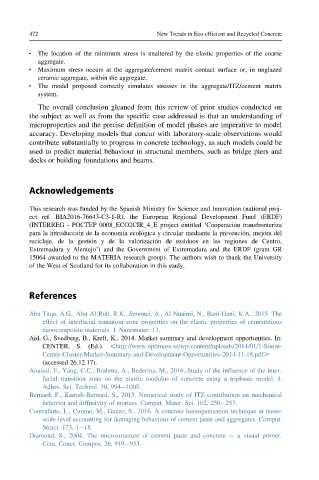Page 524 - New Trends in Eco efficient and Recycled Concrete
P. 524
472 New Trends in Eco-efficient and Recycled Concrete
The location of the minimum stress is unaltered by the elastic properties of the coarse
aggregate.
Maximum stress occurs at the aggregate/cement matrix contact surface or, in unglazed
ceramic aggregate, within the aggregate.
The model proposed correctly simulates stresses in the aggregate/ITZ/cement matrix
system.
The overall conclusion gleaned from this review of prior studies conducted on
the subject as well as from the specific case addressed is that an understanding of
microproperties and the precise definition of model phases are imperative to model
accuracy. Developing models that concur with laboratory-scale observations would
contribute substantially to progress in concrete technology, as such models could be
used to predict material behaviour in structural members, such as bridge piers and
decks or building foundations and beams.
Acknowledgements
This research was funded by the Spanish Ministry for Science and Innovation (national proj-
ect ref. BIA2016-76643-C3-1-R), the European Regional Development Fund (ERDF)
(INTERREG - POCTEP 0008_ECO2CIR_4_E project entitled ‘Cooperacio ´n transfronteriza
para la introduccio ´n de la economı ´a ecolo ´gica y circular mediante la prevencio ´n, mejora del
reciclaje, de la gestio ´n y de la valorizacio ´n de residuos en las regiones de Centro,
Extremadura y Alentejo’) and the Government of Extremadura and the ERDF (grant GR
15064 awarded to the MATERIA research group). The authors wish to thank the University
of the West of Scotland for its collaboration in this study.
References
Abu Taqa, A.G., Abu Al-Rub, R.K., Senouci, A., Al-Nuaimi, N., Bani-Hani, K.A., 2015. The
effect of interfacial transition zone properties on the elastic properties of cementitious
nanocomposite materials. J. Nanomater. 13.
Aid, G., Svedberg, B., Kreft, K., 2014. Market summary and development opportunities. In:
CENTER, S. (Ed.). ,http://www.optimass.se/wp-content/uploads/2014/01/1-Simm-
Center-Cluster-Market-Summary-and-Development-Opportunities-2014-11-18.pdf.
(accessed 26.12.17).
Aouissi, F., Yang, C.C., Brahma, A., Bederina, M., 2016. Study of the influence of the inter-
facial transition zone on the elastic modulus of concrete using a triphasic model. J.
Adhes. Sci. Technol. 30, 994 1005.
Bernard, F., Kamali-Bernard, S., 2015. Numerical study of ITZ contribution on mechanical
behavior and diffusivity of mortars. Comput. Mater. Sci. 102, 250 257.
Contrafatto, L., Cuomo, M., Gazzo, S., 2016. A concrete homogenisation technique at meso-
scale level accounting for damaging behaviour of cement paste and aggregates. Comput.
Struct. 173, 1 18.
Diamond, S., 2004. The microstructure of cement paste and concrete a visual primer.
Cem. Concr. Compos. 26, 919 933.

